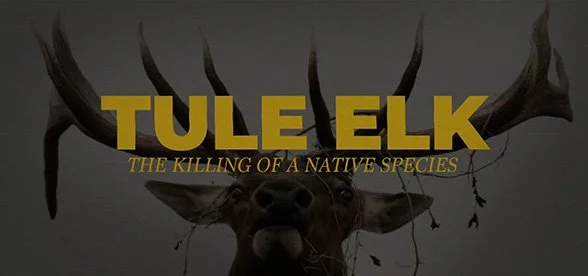The Killing of a Native Species
Resource Renewal Institute is proud to present our new film about Point Reyes National Seashore
Confined by a fence, Tule elk at Point Reyes National Seashore are in mortal danger as their water sources dry up. Half the herd died during the 2014-2016 drought. The park’s biologist referred to the die off as “letting nature take its course.” There’s nothing natural about denying water to confined animals. The just-released management plan (described below) calls for shooting wild elk to ensure enough grass for the nearly 6,000 cattle that graze the park. Learn more. Take Action.
New Park Service Plan a Giveaway to Ranchers
Disregarding climate change, science and more than 7,000 comments from the public, the National Park Service has released its final General Management Plan Amendment (GMPA) for ranching at Point Reyes National Seashore. The plan extends 20-year leases to the 24 ranchers that graze beef and dairy cattle in the national seashore, and calls for killing native Tule elk that the ranchers complain eat grass on parkland they lease for their cattle.
“The Park Service will portray the plan as balanced, but the ranching interests clearly had their thumb on the scale," said Deb Moskovitz, president of the Resource Renewal Institute, the nonprofit organization in Mill Valley, California that sued the Park Service in 2016 after 250 rare Tule elk in the park died during the drought. “Their new plan is essentially the ranchers’ wish list— a giveaway of public resources to special interests.”
The final plan is little changed from the controversial draft plan the NPS floated last year that drew thousands of public comments. The NPS’s chosen alternative, Alternative B, is the only one of the six alternatives that expands ranching. The other five alternatives the Park Service considered ranged from no ranching to reduced ranching to keeping the status quo.
Alternative B reflects demands the Seashore Ranchers Association sent in a letter to the Seashore Superintendent in 2014 that included long-term leases, diversifying livestock, growing commercial crops, setting up retail farm stands and hosting overnight guests and private events at ranches they occupy in the national park.
The NPS’s new plan for Point Reyes Seashore permits all of the above. Ranchers may continue to live in the park and raise chickens, sheep, goats, and pigs in addition to their nearly 6,000 cattle. This adds growing concerns about how the NPS manages wildlife. Native predators in the park include coyotes, bobcats, cougars, badgers, and raptors that could prey on small livestock.
Established by Congress in 1962, Point Reyes is the only national seashore on the Pacific Coast. The United Nations designated it an International Biosphere Reserve in 1988. In addition to the approximately 600 native Tule elk, a species found in no other national park, the Seashore harbors a hundred listed rare, threatened and endangered species.
In its first-ever Environmental Impact Statement (EIS) on ranching at the Seashore, the NPS “analyzed” overgrazing, water pollution, habitat loss, and methane emissions—impacts the NPS acknowledges would not exist were there no cattle in the park. The NPS considers the ranches, which were founded in the mid-19th century, to be historic resources, though ranching operations and extensive infrastructure have been modernized.
Ranchers sold these lands to the NPS 50 years ago, yet have managed to remain in the park more than 25 years after their occupancy agreements expired. They graze cattle on 28,000 acres of parkland. The NPS reports it receives about $500,000 in revenues from the ranch leases—less than half the amount the Park Service spends to maintain them.
There is a 30-day pause before the plan is finalized, while state and federal agencies review it.
“We are disappointed, but not surprised, that the NPS has chosen to double down on its support for the ranches,” said Chance Cutrano, Director of Programs for the Resource Renewal Institute. “There’s no scientific, economic or public benefit that justifies the plan. It’s essentially a “taking” of public land by a well-connected few. There’s no other explanation.”
Photographer Matthew Polvorosa Kline is documenting the plight of the Tule Elk. Follow him on Instagram.

